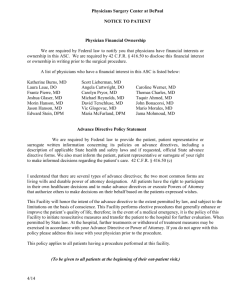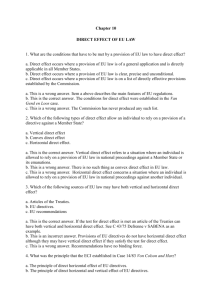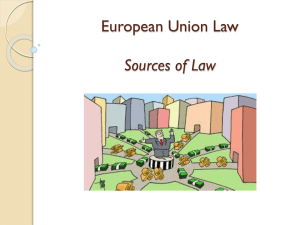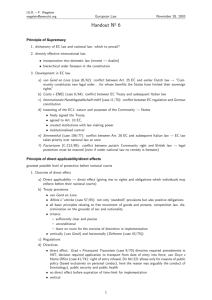NO HORIZONTAL DIRECT EFFECT for DIRECTIVES
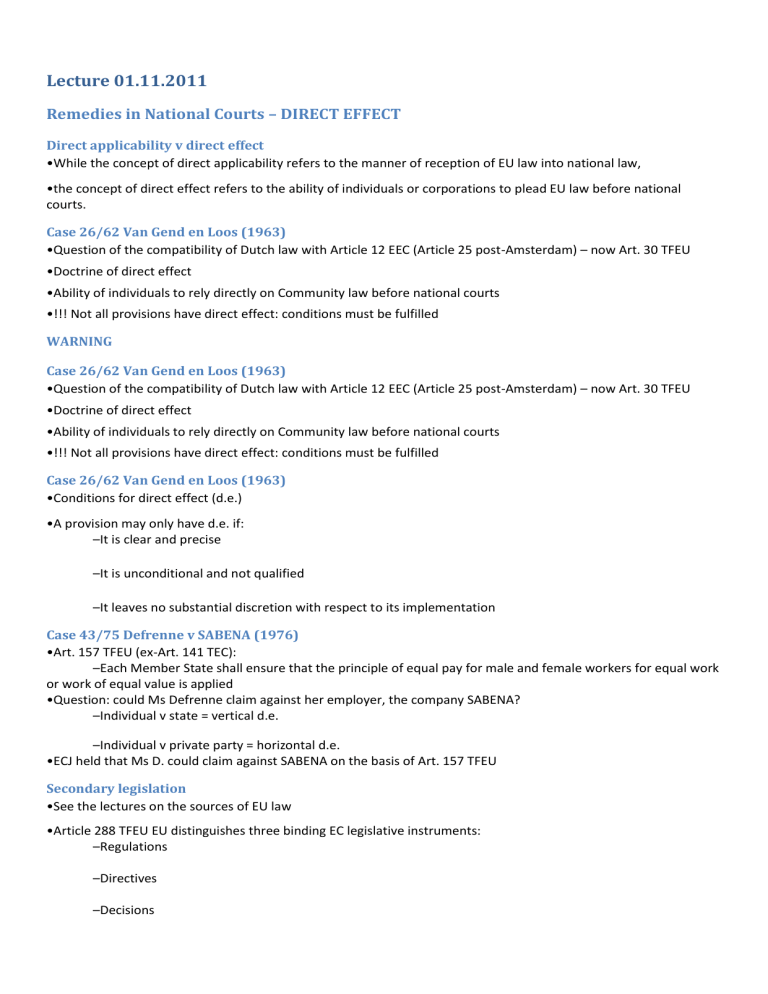
Lecture 01.11.2011
Remedies in National Courts – DIRECT EFFECT
Direct applicability v direct effect
•While the concept of direct applicability refers to the manner of reception of EU law into national law,
•the concept of direct effect refers to the ability of individuals or corporations to plead EU law before national courts.
Case 26/62 Van Gend en Loos (1963)
•Question of the compatibility of Dutch law with Article 12 EEC (Article 25 post-Amsterdam) – now Art. 30 TFEU
•Doctrine of direct effect
•Ability of individuals to rely directly on Community law before national courts
•!!! Not all provisions have direct effect: conditions must be fulfilled
WARNING
Case 26/62 Van Gend en Loos (1963)
•Question of the compatibility of Dutch law with Article 12 EEC (Article 25 post-Amsterdam) – now Art. 30 TFEU
•Doctrine of direct effect
•Ability of individuals to rely directly on Community law before national courts
•!!! Not all provisions have direct effect: conditions must be fulfilled
Case 26/62 Van Gend en Loos (1963)
•Conditions for direct effect (d.e.)
•A provision may only have d.e. if:
–It is clear and precise
–It is unconditional and not qualified
–It leaves no substantial discretion with respect to its implementation
Case 43/75 Defrenne v SABENA (1976)
•Art. 157 TFEU (ex-Art. 141 TEC):
–Each Member State shall ensure that the principle of equal pay for male and female workers for equal work or work of equal value is applied
•Question: could Ms Defrenne claim against her employer, the company SABENA?
–Individual v state = vertical d.e.
–Individual v private party = horizontal d.e.
•ECJ held that Ms D. could claim against SABENA on the basis of Art. 157 TFEU
Secondary legislation
•See the lectures on the sources of EU law
•Article 288 TFEU EU distinguishes three binding EC legislative instruments:
–Regulations
–Directives
–Decisions
The Direct Effect of Regulations
Case 39/72 Commission v Italy (1973):
“All methods of implementation are contrary to the Treaty which would have the result of creating an obstacle to the direct effect of Community Regulations and of jeopardising their simultaneous and uniform application in the whole of the Community...”
The Direct Effect of Decisions
Case 9/70 Franz Grad (1970):
“It would be incompatible with the binding effect attributed to decisions...to exclude in principle the possibility that persons affected may invoke the obligation imposed by a decision.”
The Direct Effect of Directives
Art. 288 TFEU: directives are binding as to the result to be achieved by MS
•MS benefit from an implementing period giving them time and discretion to achieve the result prescribed by a directive
•If directives are implemented correctly and within the time specified, then rely on domestic implementing law to assert your rights – d.e. is irrelevant
•Problem arises when Community directives have not been properly transposed into national legal orders
The Direct Effect of Directives
When a MS has failed to implement an EU directive or has implemented it incorrectly, can an individual invoke the provisions of the directive itself before a domestic court?
And, if so, against WHOM?
Case 41/74 Van Duyn (1974)
•”[W]here the Community authorities have, by directive, imposed on Member States the obligation to pursue a particular course of conduct, the useful effect of such an act would be weakened if individuals were prevented from relying on it before their national courts and if the latter were prevented from taking it into consideration as an element of Community law.”
•As in Van Gend en Loos, the Court has placed a strong emphasis on the notion of effectiveness
Effectiveness of EU0 law
•Direct effect is intended to ensure the effectiveness of EU rights
•Effectiveness of direct effect increased with the doctrine of supremacy
•Case 6/64 Costa v ENEL (1964)
–“The law stemming from the Treaty, an independent source of law, could not, because of its special and original nature, be overridden by domestic legal provisions, however framed, without being deprived of its character as
Community law and without the legal basis of the Community itself being called into question.”
Effectiveness of EU law
•Case 11/70 Internationale Handelsgesellschaft (1970)
–All kinds of national rules, irrespective of their domestic legal status, must be disapplied if they are in conflict with
EU Law obligations
–EU law has supremacy in areas of its competence, even in relation to constitutional measures
•Case 106/77 Simmenthal (1978)
–National courts must apply Community law in its entirety… and must accordingly set aside any domestic provision that may interfere with the aim of giving supremacy of EU Law practical effect
… back to the direct effect of directives
Case 41/74 Van Duyn v Home Office (1974):
-- Directives may give rise to direct effect, i.e. be relied upon by individuals in MS courts
-- Still necessary to ascertain whether the directive in question is in itself capable of having direct effect: clear, intended to confer rights upon individuals, looking at wording, nature and general scheme
The Direct Effect of Directives
-IF a directive is capable of giving rise to direct effect, the next question is: WHEN can an individual rely on it?
-Case 148/78 Ratti (1979):
-two directives at stake – for one the deadline for implementation had expired; not for the other
- Direct effect granted only once the deadline has lapsed and the MS has failed to implement at all or has not done so incorrectly
-Extra condition for the direct effect of directives
The Direct Effect of Directives NB:
-Case C-129/96 Inter-Environnement Wallonie (1998)
-even before the period for implementation has expired, a Member State must refrain from measures which would seriously compromise the achievement of the directive’s objectives
The million dollar question:
Against whom can you invoke the direct effect of directives?
Short, but very important answer,
ONLY against the STATE (and organs and emanations of it), so
NO HORIZONTAL DIRECT EFFECT for DIRECTIVES
Case 152/84 Marshall v SHA (1986)
•Case involving the Equal Treatment Directive of 1976 (prohibiting gender discrimination at work)
•ONLY vertical direct effect for directives
•Vertical d.e.: individual v State
•Horizontal d.e.: individual v another private party
•Health Authority held as falling within ECJ definition of “the State”
ECJ has consistently denied horizontal d.e. for directives (see Marshall, Foster, Faccini Dori, El Corte Inglés…) E.g.: C-
91/92 Faccini Dori (1994) involving the Doorstep Selling Directive of 1985
To compensate for the lack of horizontal d.e. for directive, the Court has adopted a very generous interpretation of the notion of “the State”. It includes organs/emanations, such as health authorities / a chief constable / British Gas
(prior to privatisation) / tax authorities / local authorities…
C-188/89 Foster v British Gas (1990)
Foster formula relating to authorities and other entities seen as „emanations of the state‟
-A body made responsible by the state to provide a public service
-Under the control of the State
-With special powers beyond those normally applicable in relations between individuals
BROAD DEFINITION OF THE STATE TO MITIGATE THE DENIAL OF HORIZONTAL DIRECT EFFECT OF DIRECTIVES
The Direct Effect of Directive
Applies only when a directive is capable of having direct effect in the first place (Van Gend en Loos conditions must be fulfilled)
AFTER the implementation time has lapsed
When a MS has failed to implement / has implemented erroneously
NO horizontal direct effect
So… if direct effect is impossible – and the definition of “the State” cannot be „stretched‟ any further, is there
another „way out‟?
FIND OUT ON FRIDAY, 3 NOVEMBER!

